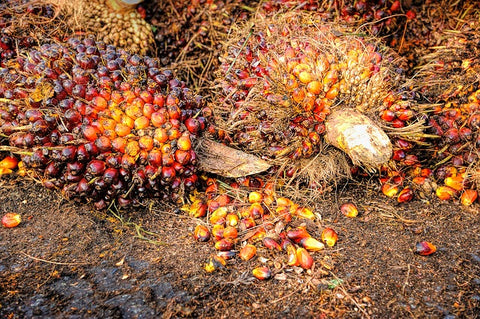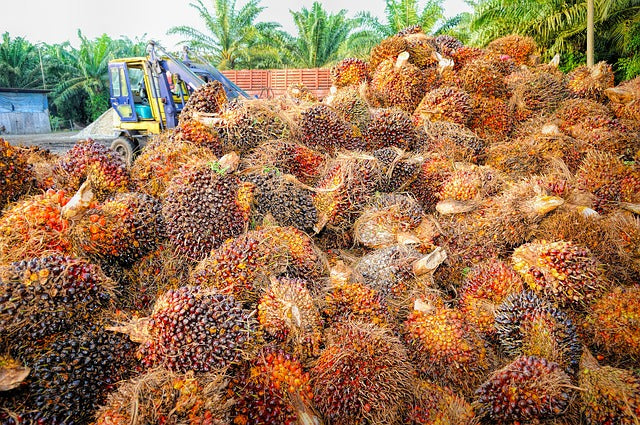The Truth About Palm Oil
What is palm oil used for?
Palm oil is a common ingredient used in many cosmetic products you will often see it listed as sodium palmate. It is also commonly used in food, but it is mostly used as bio fuel. It is either mixed with fuels for cars with combustion engines or sent to bio fuel power plants to be burnt in huge quantities to produce electricity.
What is good about palm oil?
Crude palm oil is generally 50% saturated fat, 40% monounsaturated fat and 10% polyunsaturated fats. It is vitamin rich and contains a wide variety of nutrients such as vitamin A and E. It is used as a medicine for people deficient in vitamin A and for victims of famine. Palm oil contains the highest concentration of oil than any other vegetable because it can store higher concentrations of carbon. The palm oil crop has boosted huge amounts of cash into previously struggling economies in the tropics, it is the most profitable legal way to use land in the tropics and has resulted in better access to schools and healthcare in poverty ridden countries where it is grown.
Is sustainable palm oil really that sustainable?
The current movement to establish sustainable palm oil is obviously a step in the right direction however when you dig into the criteria that needs to be met in order to label your palm oil as sustainable palm oil it does not seem sustainable in my opinion. In 2004 an organisation was set up to establish standards for the palm oil industry that organisation is the roundtable on sustainable palm oil (RSPO) and they are currently the largest sustainability organisation in the palm oil industry. In order to attain certification from RSPO palm oil plantation needs to be well managed and have good environmental, social and economic standards.
Sounds great so far yes? Well... the truth is under rules from the RSPO you can achieve sustainable palm oil status as a palm oil producer even if you have deforested huge areas of forest and/or destroyed peat lands if your plantation was set up after 2005. Granted that land cleared is not allowed to be "high value conservation forest," but what classifies as high value is open to interpretation.
Palm oil producers and retailers are also allowed to do a little trick called, "mass balance" this means they can mix certified and non certified palm oil and as long as they do not mix more non certified palm oil than certified palm oil the mixed palm oil becomes certified.
The horrors of modern day palm oil production

Amount of land used for palm oil production
Currently oil palm plantations cover more than 27 million hectares of the planet (New Zealand is roughly 27 million hectares) . The world's largest palm oil plantations exist in Indonesia, in 2014 the largest palm oil plantation took up over 6 million hectors of land (Belguim is roughly 6 million hectares) in 2015 plans were accepted for it to expand a further 4 million hectors. The worlds entire palm oil supply comes from land that used to be Indonesian rainforest, which is currently the world's 3rd largest rainforest. Indonesia is also ranked 3rd largest in terms of greenhouse emissions and the majority of those emissions are purely from chopping down and burning rainforest to clear land for oil palm plantations.
Environmental impact of palm oil production
The epic scale of the deforestation in Indonesia purely for palm oil is a serious threat to the environment, the green house gases cause global warming and wilderness is destroyed with many already endangered species being pushed further to the brink of extinction. It is impossible not to mention one of the biggest losers of the palm oil industry and that is the orangutan. In 1990 it was estimated that there were 315,000 orangutans in the wild and now there are fewer than 50,000 and the future of those 50,000 is looking bleak. Those remaining organutans are split into small groups and the rainforest between them is disappearing turning into palm oil plantations. Organutans are an endangered species commonly used to highlight the damage being caused by palm oil as they are the easiest for us to relate to but there are so many different species at risk. Other endangered species at risk from palm oil include; Sumatran Tigers, Sumatran Rhinos, Bornean Pygmy Elephants and Sumatran Elephants.

Modern day slavery and child labour used for palm oil productions
The plantations are also rift with modern day slavery and child labour, most tend to use a form of slavery called debt slavery where people obtain debt in order to survive and are then forced to work on plantations to repay their debt, if that person dies then their debts are passed onto their children which forces children to work to pay of the debts of their parents as well as getting deeper in debt themselves. Reports from sustainable palm oil plantations include reports of workers earning as little as $2.50 for a full day's work and being forced to work long hours with no safety equipment in a dangerous environment even when they are being exposed to hazardous chemicals.
The forest fires and smog caused by palm oil production
When land is cleared for palm oil plantations the easiest and cheapest way of clearing the rainforest is to slash and burn. This practice is supposed to be illegal because the fires often spread out of control and destroy conserved forested areas. They also produce a dense smog that spreads over hundreds of kilometres. In 2015 the Indonesian government was forced to declare a national emergency because of smog from areas of forest burnt down for palm oil. 28 Million people in Indonesia were impacted and 140k people ended up with respiratory illnesses such as infections and pneumonia. Other people reported more minor health issues such as skin irritation and eye irritation for example. The smog emergency resulted in school closures in Indonesia, Malaysia and Singapore. It cost the economies of South East Asia $47 billion US dollars. A smog emergency happened again in 2016, this time it led to the Indonesian government making 454 arrests for forest fires and issuing a fine of $81 million US dollars to a palm oil plantation company called Sago. Despite fines and arrests in 2017 Indonesia declared a state of emergency again due to smog from forest fires, even with fines and the risk of arrest it is still cheaper for palm oil plantations to burn rainforest and peat land.
Sources
https://www.emmassoap.co.uk/blog_4.asp
https://www.emmassoap.co.uk/blog_9.asp
https://www.rainforest-rescue.org/topics/palm-oil
https://www.nationmaster.com/country-info/stats/Geography/Area/Total
https://greenpalm.org/about-palm-oil/social-and-environmental-impact-of-palm-oil

